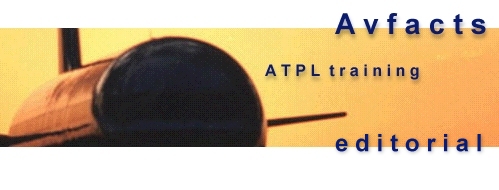




 |
 |
  |
 |
Aircraft Systems Topic 5.
The Conventional Airspeed Indicator
| General This type of instrument is that found in non-EFIS aircraft, and in EFIS aircraft as a standby airspeed indicator in case of EFIS failure. We will discuss the various readouts and relevance of needles, pointers, etc. Firstly it is important that you understand that the airspeed readings are Indicated Airspeed (IAS), not True Airspeed (TAS). Some more modern aircraft have any instrument and position errors automatically calibrated out (removed) by the Central Air Data Computer, and thus readings taken from this gauge would then be Calibrated Airspeed (CAS), or as it is sometimes called Rectified Airspeed (RAS).
VMO needle This is sometimes referred to as the "Barbers Pole," as it is usually painted with red and white stripes. Red means danger, and flying in excess of this speed is extremely unwise, even in smooth air. VMO by definition is the maximum operating speed expressed as an IAS. This needle could just as easily be called a VMO/MMO needle, as it will indicate the IAS which would produce an exceedance of the maximum operating Mach number (MMO) when above VMO/MMO "Changeover Level". If VMO for this particular aircraft type was say 340 KIAS, and MMO was say Mach 0.85, then the needle would stay at glued to 340 KIAS during the climb up to VMO/MMO Changeover Level (FL280 with this combination), then would fall thereafter as the needle now represents MMO. Remember that climbing at a fixed Mach number produces decreasing IAS values as altitude is gained. (Refer to some of the previous training editorials on airspeed/Mach number relationships). If VMO or MMO is exceeded an aural warning will sound in the cockpit, the volume of which is enough to wake the dead. The only way you can silence the warning is to slow the aircraft down to below the VMO/MMO limit speed. Command Airspeed Bug This is the speed you command the aircraft to fly at. The autothrottle will work in association to produce this speed for you (assuming you engage the autothrottle that is). The bug value can be set using the Command Airspeed Bug Set Knob. On some aircraft such as the B767/A320 the value is set in the Airspeed Window on the Autopilot/Flight Director Mode Control Panel, sometimes referred to as the "Glareshield Panel", rather than being set using a gauge mounted knob.
Airspeed needle Obviously, if you are not to exceed VMO or MMO you had better keep the airspeed needle at a value less the that pointed at by the VMO/MMO needle. Current Airspeed Digital readout This simply display’s the value that the IAS needle is currently pointing at. It is easier to read and interpret quickly than is the needle itself. In this case the IAS needle must be pointing at 310 kt. In older aircraft such as the B727 (non-EFIS), the digital readout was basically a rotating drum with numbers painted on it. Later aircraft used Liquid Crystal Digital displays such as that found on your common pocket calculator. Current Mach number Digital readout Identical to the Airspeed digital readout, only showing the aircraft’s current Mach number. If you are climbing at a fixed IAS, the Mach number value will be increasing as altitude is gained. External index pointers These are set using your finger. They are used as a quick reference to display the calculated values of such things as V1, Vr, V2, and approach speed Vref. Setting these help you quickly reference the position of the airspeed needle to such datum values, making scanning much quicker and more accurate. I hope that this mini training editorial helps you in your studies. Further Airline Pilot training texts such as these are available at most pilot supply shops around Australia, or through the secure ONLINE SHOP at this website for those of you with plastic money. This editorial is infact a condensed extract from the training textbook on "Airspeed/Altimetry/ETP/PNR". A list of approved distributors is available within the Avfacts site. ATPL training course information is also available within the Avfacts website. Finally, good luck with your studies, and remember ... Pilots are the ultimate professionals - strive to be one ! Best Wishes Rob Avery
|
